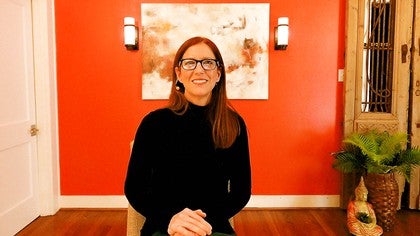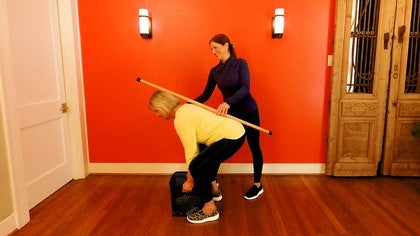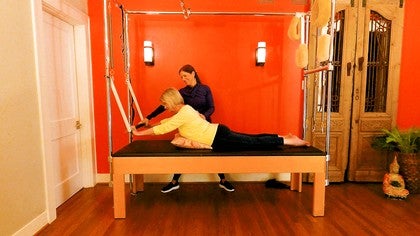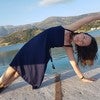Description
Links and Resources
- Class 3129 - Strengthening Reformer
- Class 7464 - Bone-Building Reformer
About This Video
Transcript
Read Full Transcript
Hi, everyone. I'm Dr. Sherri Betz. And I am here to give you the latest research on exercise for osteoporosis, that you can start to incorporate with your clients on Monday morning. What most osteoporotic patients hear, is that you have the bones of a 90 year old. Don't lift more than 20 pounds.
You just need to walk. Walking builds bone density. Walking doesn't build bone density. You need to get on medications to keep your bones from crumbling. There are so many gaps in the knowledge of exercise for bone building and strengthening in all of the older adults out there.
In this particular study, led by Dr. Lora Giangregorio, of the Osteoporosis Canada group, 242 community-dwelling participants surveyed in 2018, reported specific gaps in knowledge pertaining to strength training. When they were asked to describe things like a back extensor exercise, they would often lie on their back and bring their knees to their chest. They also demonstrated really poor understanding of good alignment and postural correction cues. So many different concepts are misunderstood. Daily activities, where do they find resources?
How many reps do they do? How many sets? What is the frequency of a weekly exercise program? How often should they you do the strength exercise? What's the best kind of exercise? Does it matter if you walk fast or slow, or hike?
Does it matter how intense you exercise? How do you modify activities and hobbies to keep them safer? What do I need to avoid? There are just a plethora of things that people have questions about, and that having a better understanding of what patients should avoid, and what they should do to build their strength. How can you keep them safe in your Pilates studio, while they exercise with you?
And how can you be effective? Not just safe, but effective. 51 participants were surveyed in this particular study, by Watson. This group is at Griffith University, in Australia, and is led by Dr. Belinda Beck. They are doing a lot of research on exercise intensity and strength training for women who have osteoporosis.
This study was conducted in 2019, and they were looking to see if high intensity exercise would cause any injuries or fractures. And did it actually improve thoracic kyphosis? And what they found in the particular participants that had vertebral fractures, that they had no loss of height, no increase in Kyphosis, and no additional vertebral fractures. However, the control group who didn't do any exercise at all had additional wedge fractures. So what they've found is, with high intensity strength training, like deadlifts squats, and overhead presses, at 80 to 85% of one repetition max, there were no adverse injuries, so are adverse events.
Dr. Lora Giangregorio from Osteoporosis Canada conducted another particular study about recommendation of exercise. She looked at 140 community-dwelling women over age 65, with at least one radiographically confirmed, Genant vertebral compression fracture. There were six non-vertebral fractures in the intervention group, and four in the control group. And the only reason that there were those fractures is that, they slipped or tripped in and around their home. There were no between group differences in false fractures or adverse events in the control group that did the exercise versus the group that did not exercise.
And there were no serious adverse injuries directly attributable to the intervention. Sherrington in 2016 also stated that, based on their evidence, there was strong evidence that particularly challenging balance exercises can reduce falls by about 20 to 40%. So Dr. Lora Giangregorio used that evidence to make the recommendation that people add fall prevention and balance exercises to prevent vertebral fractures, because we already know that most vertebral fractures actually occur because of falls, not just lifting something heavy or sneezing or coughing as sometime does happen. Alonso Perez did a really nice update of the muscle strengthening exercise effectiveness in postmenopausal women with osteoporosis. They performed a qualitative systematic review, looking at 16 studies.
Seven of the studies looked directly at bone density as an outcome measure, and showed favorable results in the femoral neck, the lumbar spine, and the tibia after exercise programs. The studies were published from 2008 to 2019, and ranged from 10 to 52 weeks. Unfortunately, there's a low level of methodological quality and lack of homogeneity that leads to a little bit contradictory evidence in most of these studies. And that's usually how it goes with exercise studies. It's really hard to keep people in long-term exercise studies, especially for bone density, because it takes a long time to get the benefits of an exercise program, and really see the turnover in bone.
It takes about six months to eight months at a minimum, to see any changes in bone-related to exercise. So the studies really need to be longer. And I really think that in the past, The Literature showed that there wasn't that much effect of exercise, because I think the studies were too short. And now we understand that if we conduct the trials for a longer period of time, we will see some better outcomes. So that's really promising for the future.
What Alonso Perez found mainly, was that high intensity multi-component exercise was more effective, and longer duration programs were also found to be more effective with their outcomes. So multi-component means that it's not just one type of exercise, so it's not just strength training, or just walking, or just swimming, or just Tai Chi, it's a combined exercise program where they're doing walking, or jogging, or you know, exercise for endurance on your feet, plus a strength training program. Holubiac did a really nice explorative literature review in 2019, looking at the influence of physical exercise on bone mineral density. What they found was that, practicing physical exercise has positive effects on bone mineral content and the peripheral region of bone. But the bone density changes are often not as visible on the DEXA scans.
The degree of muscle strain and stress has a greater impact on osteogenesis, regardless of whether the activity involves the transport of weight. So this is important for Pilates, because we don't always lift weights in Pilates, right? We don't really do dumbbell training. We have springs for resistance, which is good, so that we know that if we imply strain or stress to the bones, we will see that it doesn't really matter if we're using TheraBand, kettlebells, springs, dumbbells, barbells, whatever it is that we wanna use for resistance, will also work, as long as we're placing strain or stress through the bones in a healthy way. Prolonged exercise periods we're also found to not be as effective as short-term bouts of high intensity exercise, followed by rest periods.
Rest is just as important as exercising. You can't exercise high intensity every day and expect your bones to get stronger. They will actually weaken over time if you do too much. So you have to use the Goldilocks principle, and do just enough. You always have to have that day of rest in between.
Another thing that people always ask me that was answered in this study was that, wrist or ankle weights do not enhance the effectiveness of exercise on bone density. And so that would mean that, if you are walking with ankle weights, or walking with wrist weights, or walking even with a weighted vest, that's not gonna enhance the effectiveness of the exercise on bone density, and may actually be harmful to your joints. So you don't wanna add additional stress when you're doing your endurance activity. The seated leg press machine at the gym was found to be more effective at targeting the proximal femur than walking or running endurance exercise, in this particular review. What about exercise combined with medications?
Kistler-Fischbacher, who was a grad student of Dr. Belinda Beck, at Griffith University, in Australia, part of the LIFTMOR group, was looking at exercise combined with medications, but also comparing high intensity resistance training exercise to Pilates-based exercise. There were four different groups, it was high intensity strength training group plus medications, high intensity strength training group minus medications, that were not on medications. And then the same with the Pilates group, with and without medications. There were 115 healthy postmenopausal women in this group. So I think it's important to know that they were healthy, they did not have osteoporosis.
Some had low bone mass, and some had a low body mass index, but they were all on or off stable doses of antiresorptive medications. They were randomly allocated to an eight month, twice weekly, 40 minute resistance training class, or a Pilates class. What they found, was that the high intensity resistance training improved lumbar spine bone density, stature, and leg and back muscle strength, as examined by the Five Times Sit-to-Stand test. So what they found was that, that was more effective than the Pilates exercise program. But, what I want you to think about with this is that, if you combine just a little bit of Pilates strengthening, because the LIFTMOR study only has four exercises that they do in their study.
So how simple is that, to include in your Pilates programs? To add four high intensity strength training exercises to your patient or client programs. Both programs were shown to improve functional performance. And there was a positive relationship between the maximum weight lifted, and changes in the lumbar spine bone density and the muscle strength, in the high intensity resistance groups. The exploratory analysis after the study was conducted, suggested that the anti-resorptive medication also may enhance the exercise efficacy at the proximal femur and the lumbar spine.
So the nice thing is that, if you take medications for your bones without doing any stimulus, mechanical stimulus, like exercise or vibration, you're not gonna get the kind of results that you would if you are adding the exercise with the antiresorptive drugs. Kistler-Fischbacher also did a recent review on the effect of exercise intensity on bone. And they're really on like the bandwagon about looking at how much exercise intensity is required to get the stimulus that you want. So they looked at studies that included any type of exercise intervention, such as walking, water-based training, resistance or impact training. They had to have a minimum duration of six months, and those were the only studies that were eligible for the review.
They found 3,200 studies, and that they found that only 100 about the actual inclusion criteria, they all included postmenopausal women. Two studies included mat Pilates. That was by Angin 2015, and De Olivera 2018. What they found was that, low intensity exercise is largely ineffective as a bone intervention, high intensity exercise is likely the most effective stimulus for bone. And here you're gonna hear this again, combined resistance and impact exercise regimens are the most effective.
My colleague, Dr. Wendy Katzman, who I just adore, she was a professor at UCSF for many years, and has recently retired, but is continuing to publish research. She just spoke the other night through the American Physical Therapy Association, Academy of Geriatric Physical Therapy journal club. They do a presentation by an author, and a case based on the study or the research. And they do a great job of really interpreting the research, letting us have a chance to ask the author's questions, and also helping us implement the research into individual cases. So that can go for a physical therapy patient, or it could go for a Pilates student that you're working with.
So her Stand Tall exercise program has been well researched over the years for reduction of thoracic Kyphosis. What she did was, she took a look at the three month kyphosis intervention that she conducted in 2017, which back then, showed improvement in several measures of function and health-related quality of life measures. Then she did a year follow up study of this same group, and they found that lordosis improved by quite a bit. And there was also improvements in Kyphosis, gait speed, physical activity level, and upper body strength. And mainly, they didn't actually increase in kyphosis over those three years, but they didn't change, they didn't decline in Kyphosis.
Were supposed to have about a 1% decline per year. I'm not really clear on that number. There have been a few numbers thrown out there, but we know that there is a decline every year, and I think it's about a five to 10% every decade in Kyphosis curvature that increases over time, as a patient ages. And so what we're trying to do mostly, is stabilize the kyphosis at a minimum, and if we can improve it, how good would that be? When I did the assessment on Peggy, who I did the Pilates intervention on, using the Ped-o-Pull and the spine corrector, and working on her thoracic kyphosis, I actually saw a 20% reduction in her Kyphosis in one session, and I hope you'll take a look at that tutorial coming up.
What Wendy Katzman also found was that long-term improvements can also be expected for a lot of physical measures and quality of life measures, even after a three month short-term kyphosis intervention. Here, I wanna talk about the LIFTMOR trials. These are going crazy like gang busters. I just heard a talk by Dr. Clint Rubin, who does research on vibration, and he is teaming up with Belinda Beck, to see if vibration plates actually have any additional benefit or supplement to their exercise programs. They have really worked on low intensity vibration platforms.
And as opposed to the power plate, the power plate is a very high intensity, kind of vibration platform. Marodyne, Juvent is the platform that Dr. Clint Rubin has been working on developing and doing the research on. He also did research on NASA, astronauts going up in space. And he was one of the main researchers who was trying to help astronauts prevent the bone loss that occurs during space travel. When they return, they were having fractures and loss of bone density.
And what they did eventually was, they tethered the astronauts down to treadmills and made them exercise on a regular basis, to help keep their bone strong. And a lot of the anti-resorptive or bisphosphonate drugs were developed for the astronauts as well. So they really added to our knowledge of how gravity is so helpful for our spines. So let's get back to the LIFTMOR trial, what Belinda Beck found in 2015, and also Watson, her graduate student, who published this trial. They looked at heavy resistance training as effective, safe, and approved bone function, and stature in postmenopausal women with low to very low bone mass.
These were some novel, early findings that were originally presented. Now, what I'd like to do is show you the form and alignment, and the exercises, all four of them are shown here in a news report, where Dr. Belinda Beck is interviewed. And I'm concerned about the alignment of the spines of these women, and I think it actually can be improved. I do think that we need to be doing high intensity strength training, but I think there needs to be a better focus on alignment. So when I first saw this trial in 2015, I was really excited to look at it on paper, but then when I saw the actual women doing the exercises, I was a bit concerned.
So, we'll see what you think. [Lexy Hamilton-Smith] These women are working out to beat brittle bones. Chin over the bar. Good. Now come down. [Lexy Hamilton-Smith] It's a new way to prevent crippling osteoporosis, high intensity weight training instead of low impacts.
When you are older and you have osteoporosis, those kinds of exercises were always thought to be dangerous. [Lexy Hamilton-Smith] But the eight month study by Griffith University has found the opposite. Since this, I don't fall. [Lexy Hamilton-Smith] These women, all over 60 have built up bone mass and recorded less falls. Had no strength whatsoever.
[Lexy Hamilton-Smith] Now, Robin Anderson is deadlifting. Between 50 and 55. [Lexy Hamilton-Smith] Almost her body weight. Sue (indistinct) personal best is 72 kilos. Since.
We've had amazing results compared to the results that you typically see in The Literature. We do have some women who have fallen over, but they haven't broken a bone. [Lexy Hamilton-Smith] Because they are stronger. Coming here, I've built up my spine 8%. They tell me that my back is straightening up.
There are 6 million osteoporosis sufferers in Australia. Between them, they get a fracture every three minutes. The bone clinic's program is scientifically designed, and involves just two sessions a week. I go home and I say, I lifted 32 Ks today, and he's just amazed. [Lexy Hamilton-Smith] Beating osteo one lift at a time, Lexy Hamilton-Smith, 7NEWS.
All right. So now, what did you think of the alignment of these women in the study? I really do think that, the Pilates teacher has a great eye for alignment, and could make some improvements in keeping the spine in alignment as people lift. I think that whatever someone starts with, they should stay with, and they do their best to improve that thoracic kyphosis, and maintain it throughout the lift. If it curves additionally, during a lift, that's when the lift should not be done with whatever amount of weight is on the either barbell or in the box. And as soon as that curvature increases, with the whatever amount of weight that you've asked them to lift, that's when you stop them, and either remind them about their alignment, or take some of the weight out of the box.
So, we'll be talking about that a lot in upcoming tutorials. The intervention group for the LIFTMOR trial did the deadlift, which is just picking up something off the floor, like a barbell or a box. And they used barbells in the particular study. The squat, which is putting the barbell on the back. An overhead press, and then jumping chin-ups with drop landings.
So they did a chin-up, where they jumped up, and then pulled their chin over the bar, and then slowly lowered down, and then drop down for that impact landing. The control group did stretching, walking, balancing, and low intensity strength training. Now, there are many follow up trials to this LIFTMOR trial that you'll be seeing published in The Literature, and you'll wanna keep your eyes open for her continued research. It's really amazing. Benedetti did an excellent review on looking at weightbearing exercises, such as walking, stair climbing, jogging, and Tai Chi, and found that aerobic training with high intensity and speed, interspersed with jogging, climbing and stepping, was able to limit the loss of bone density.
In strength and resistance exercises, to be effective, they found that a joint reaction for superior to common daily activity, with specific muscle strengthening is recommended. With either loading, lifting weights, or progressive resistance exercise. And that can be using TheraBands, springs, or whatever you want to add resistance. And again, you're gonna see this word again, multicomponent exercises were recommended, such as aerobics, jumping, dancing, balancing, strengthening, and progressive resistance. So doing a variety of things is much better than doing just one thing.
Walking as an isolated intervention was not found to modify the loss of bone density. However, in general, we advised to walk for at least 30 minutes a day. That's more for your cardiovascular health. I always try to tell people to separate your walking from your strength training program, because walking is for your heart, and strength training is for your bones and muscles. Progressive resistive exercise for the lower limbs is most effective for bone density increase at the femoral neck.
Challenging high impact exercise programs, such as jumping are only effective when they're associated with other low impact exercises. So that's good news for us as Pilates teachers. Strength training was shown to increase bone density at both the femoral neck and the lumbar spine. And here, they found that the use of vibration platforms can improve muscle strength in the lower limps of elderly patients, but they do not seem to induce significant changes in bone density in women. Whole body vibration studies are pretty controversial.
And most of the studies that I've looked at, over the years, have been ineffective for building bone or stimulating bone, but there has been one by Verschueren, in 2004, that was published, that showed a 1.5% increase in bone density in their subjects. And that's really the only one, and which is why I haven't strongly advocated getting a vibration platform. The Too Fit to Fracture consensus is one of my favorite statements or papers published on exercise recommendations. The Osteoporosis Canada group did an international consensus of research expert, or experts in the field of osteoporosis. They were clinicians and practitioners working with patients with osteoporosis.
And they were trying to identify research priorities in osteoporosis and exercise. They did an in-depth study of exercise for high risk of fracture, evaluation of multimodal interventions, and research to examine fracture outcomes. And they made a great booklet that you see here on the screen, where they published it for the consumer, and they also wrote a paper that's more directed to clinicians. So the other paper that's directed to clinicians has some excellent evidence for putting together a proper exercise program for somebody that has really high risk of fracture, maybe somebody that has a moderate risk of fracture, that wants to continue to play golf. I would highly suggest that you go to the Osteoporosis Canada website, and watch some of their video to tutorials.
I pretty much cry every time I see them, because they are so well done. And they're really informative about all the different types of clients who may be frail and have poor balance. And maybe there's an older man that wants to continue to play golf, and there may be a fit woman that's young, and would like to do more high intensity exercise in a safe manner, to help build her bone density. And they have all kinds of educational vignettes that you could take a look at. Dr. Lora Giangregorio also mentioned in the paper that there were many factors that influence the ability of vertebra to withstand loads, such as the integrity of vertebral discs.
So if there is damage to the vertebral discs, you will have more susceptibility to fracture, because you've lost the cushion between the vertebra. That presence of micro damage does make the vertebrae harder and more prone to fracture. Muscle strength also makes the vertebrae more prone to fracture, because when you lose the muscle support around the spine and around the joints, you lose the cushion and the shock absorption. And also increase spinal curvature will increase the risk of fracture as well, especially in the spine. She quotes, "It's not just the amount of weight that's lifted, but how the weight is lifted that influences fracture risk." And that's exactly what I was mentioning with the LIFTMOR trial.
If we can really look at how people are lifting the weight, and how they're distributing the forces through their spine, we can certainly help them protect their bodies from fracture. She also quotes here that, "Yoga or Pilates postures that require trunk forward flexion, rotating about the hips or the spine, or twisting to end range, particularly in sitting or standing, should be avoided or modified. To maintain mobility in the spine, slow, controlled twisting in supine or side-lying is acceptable, as is midrange, but not end-range of spine flexion and extension, with some weight supported by the upper extremities on all fours." So this is where we get the recommendations to avoid end-of-range twisting, forward bending, or side bending. There are some case reports of spine fractures that may have resulted from yoga flexion postures in individuals with low bone mass, according to Sinaki, published in 2013. Now I'd like to talk about the APTA Geriatrics evidence-based guidelines for osteoporosis.
At this time of this recording, this has not been published yet, but it should be published in the next couple of months. It has been submitted for publication, and has completed the review process. This group of authors was led by Greg Hartley and Keith Aiven. And we are presenting actually next week, at the APTA national conference, in San Antonio. And I'd like to share some of the information from on this paper with you.
So the purpose of this paper was to educate physical therapists on the best exercise to implement with their patients with osteoporosis. There are several types of exercise that has been divided in five categories, static weightbearing exercise, just like single leg standing, has been shown to slow the decline of hip bone density in postmenopausal women, but it does not have an effect on premenopausal women. Dynamic weightbearing exercise with low force, such as walking or Tai Chi, or a really low intensity dance class, and low impact dance class, does not have an effect on premenopausal women, but has been shown to slow the decline of lumbar spine bone density in postmenopausal women. Dynamic weightbearing exercise with high force, which is jumping or jogging, does not have an effect on postmenopausal women, but has been shown that to slow the decline of the femoral neck in premenopausal women. Non-weightbearing exercise with low force has no effect on postmenopausal or premenopausal women.
And that would be like a Pilates mat class, or a yoga class where you're sitting on the mat or lying down on the mat, if you're not in standing. Those kind of calisthenic exercises do not have good effects on bone for postmenopausal or premenopausal women alone. So that's the key to this, is that, that type of exercise alone is not enough. Non-weightbearing exercise with high force has been shown to have effects on both the postmenopausal and premenopausal women, slowing the bone density decline in the femoral neck and lumbar spine in postmenopausal women, and increasing the bone density in lumbar spine in premenopausal women. The good news is that, combinations of exercise types of any two of the exercise types above, has been shown to have effects on both the postmenopausal and premenopausal women, in a positive manner.
So good news is that, we can combine the exercise types, and pick any two that we really enjoy, and we get the benefits of that. Non-weightbearing exercise with high force using the Pilates apparatus can be used by modifying the reformer springs with footwork. to load the lower extremity, to achieve fatigue within 10 repetitions. We can do single leg footwork with heavy springs, double and single leg bridging, seated rows, overhead press and swimming, long stretches, such as like the plank position and pushup position, can be used using the reformer, to help to slow the decline in the lumbar spine, and possibly increase the lumbar spine in premenopausal women. Here's an example of the reformer footwork with heavy springs.
I taught this exercise on Pilates Anytime, class number 3129, and they jumpboard single leg. You can refer to the Pilates Anytime class number 7465. With this particular exercise, pelvic press and bridging, I taught this in class number 3129. And then this exercise was taught in class number 3129. This is the kneeling or seated rows.
And the reformer breaststroke, and overhead press, and swimming with weights added, was taught in class number 3129, and also in a recent class with a client named Jenny. The high force exercise using the Pilates reformer springs can be used with long stretches and long back stretch. I taught the long stretches with Jenny in class number 7464. You can always use the ladder barrel as that curved tool, along with a massage ball for home exercise program. I taught this program in class number 7463, working with Peggy, who was an older adult with thoracic kyphosis.
Then we did the Ladder Barrel Swan and the Roman chair, and that can be actually done just like the gym exercise. The GHD device can be used in the Pilates studio instead of using the Roman chair, or the GHD device, you can use the ladder barrel, and do the Swan on the ladder barrel from neutral to extension, to target the glutes, the hamstrings and the back extensors. Also using the reformer pulling straps, was taught in class number 3129. Which targets those back extensors as well. And then you can look at class number 7464, for the reformer side splits.
And class number 3129, for Eve's lunge. If you were to compare the gym exercise program to a Pilates program, even if you're doing gym machine exercises, such as leg press, back extension, rows, lat pulldown, hip AB machine, and the Roman chair at the gym. Also using the universal pulley systems to do standing rows and pull downs, much like you would do on the trapeze table, and the Ped-o-Pull. You could always add deadlifts and squats with a barbell, lunges with hand weights, and heel raises with hand weights, to any gym program or Pilates studio program, to improve its effectiveness in building bone in your premenopausal and postmenopausal patients, as well as your men. Movement priorities mainly are to protect from fracture, teach your client's neutral spine, doing a hip hinge, to be able to touch the floor and pick objects up off floor without compromising their back, avoid all side bending flexion and rotation of the spine, especially to end-range.
And when all of those are mastered, then you can think about beginning a bone-building program. You can refer to some of the classes from the Frail to Fit series for lifting instructions, and precaution to take with lifting, and how to begin a lifting program safely. Now I'd like to wrap our discussion up with the top five exercises to add for clients with osteoporosis. I believe that the hip hinge, the squat, and the deadlift, where you're touching the floor, and neutral spine, is one of the most important to be able to do, and to be able to teach your clients. Single leg standing and heel raises, adding weights as you progress.
Progressive lunges, adding weights, thoracic mobility over around surface. And then prone thoracic extensor strengthening, with a pillow under the ribs in prone. Those are my five favorite exercises to add for your clients with osteoporosis. Thank you so much for joining me today for this lecture. And I hope you learned something new, that you can add to your client programs, and increase their effectiveness in building their bones, and keeping them from fracturing for the rest of their lives.
Bone Health: Osteoporosis and Exercise
Comments
You need to be a subscriber to post a comment.
Please Log In or Create an Account to start your free trial.




















